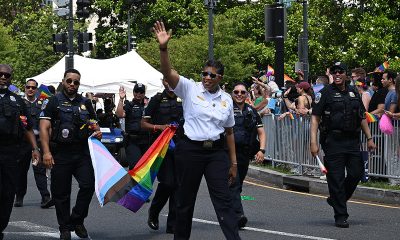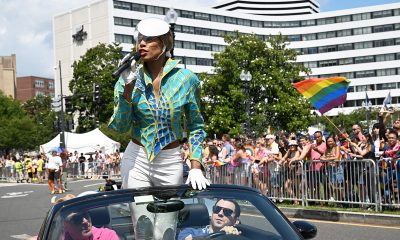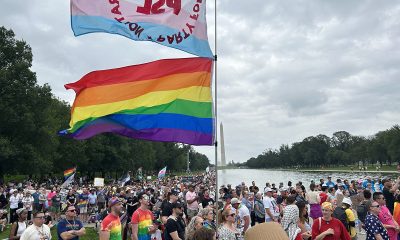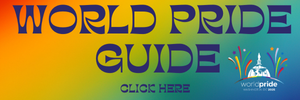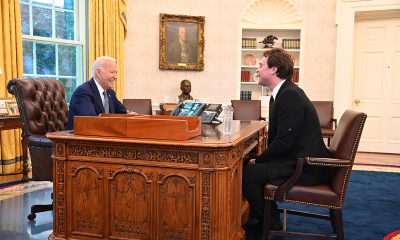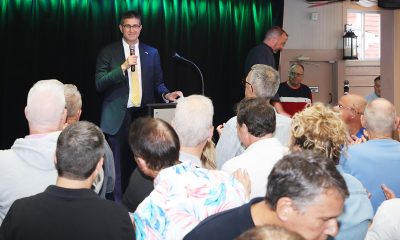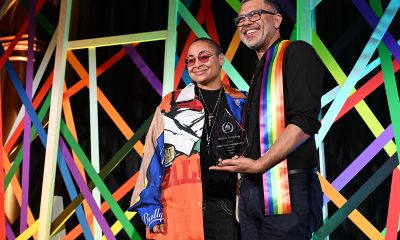National
Clinton talks N.Y. marriage in Pride speech
But no change in her opposition to marriage equality
Secretary of State Hillary Clinton spoke about New York’s new marriage law on Monday acknowledging its importance to the LGBT community and the Empire State — but she didn’t announce a change in her own stated opposition to marriage equality.
During a speech commemorating Pride month at the State Department, Clinton referenced legislation enacting same-sex marriage in New York as a monumental achievement for the supporters of LGBT rights in her audience.
A former U.S. senator from New York, Clinton called the passage of the marriage law a “historic vote” and said it “gives such visibility and credibility to everything that so many of you have done over so many years.”
Later during her speech, Clinton noted during the debate in New York a key vote toward the end was switched in favor of the marriage bill from a Republican senator from the Buffalo area whom Clinton said “became convinced that it was just not any longer fair for him to see one group of his constituents as different from another.” Clinton was presumably referring to State Sen. Mark Grisanti, a freshman senator who had sought office promising to oppose same-sex marriage.
“Senators stood up and talked about nieces and nephews and grandchildren and others who are very dear to them, and they don’t want them being objectified or discriminated against,” Clinton said. “And from their own personal connections and relationships, they began to make the larger connection with somebody else’s niece or nephew or grandchild and what that family must feel like.”
Despite the remarks and her suggestion that the lack of marriage equality in the state enabled discrimination against same-sex couples, the secretary has yet to endorse marriage equality.
Asked whether she supports gay nuptials in November during a forum in Australia, Clinton replied, “I have been a strong supporter of ending discrimination and particularly focusing on hate crimes and workplace bias and the like. I have not supported same-sex marriage. I’ve supported civil partnerships and contractual relationships, yet I am supportive of our states taking actions that they believe reflects the evolution of attitudes about this.”
Clinton’s remarks on the New York marriage win come at a time when President Obama is facing increased pressure to endorse same-sex marriage. Obama has said he’s wrestling with the idea of same-sex marriage, but has yet to endorse marriage equality. As a senior member of the Obama administration, Clinton could feel compelled to toe the line of the president when talking publicly about same-sex marriage.
Richard Socarides, president of Equality Matters, said he thinks it’s important that Clinton publicly state support for marriage equality just as he has called on Obama to declare support for same-sex nuptials.
“Given the office she holds, there are some constraints on her, but I’m not giving her a pass,” Socarides said. “I hope she would soon find the appropriate venue to go further and clearly articulate her support.”
Also during her 14-miunte speech, Clinton referenced the work the State Department has done in the past year to address LGBT issues overseas, including facilitating passage of a resolution at the United Nations recognizing the human rights of LGBT people worldwide.
“And with that we took a huge step forward in our work to refute the hateful suggestion that LGBT people are somehow exempt from human rights protections, and we made it absolutely clear that, so far as the United States is concerned and our foreign policy, and our values — that gay rights are human rights and human rights are gay rights,” she said.
Clinton’s remark that “gay rights are human rights” is a refrain from a line that she ad-libbed during her 2010 speech during a Pride event that received media attention and was echoed during other State Department events.
Identifying other accomplishments in the past year, Clinton also said U.S. ambassador to Italy David Thorne played a role in bringing Lady Gaga to Rome this month for a Pride concert.
“Now, as many of you know, Lady Gaga is Italian American and a strong supporter of LGBT rights,” Clinton said. “And the organizers of the EuroPride event desperately wanted her to perform, and a letter to her from Ambassador Thorne was instrumental in sealing the deal. Over 1 million people attended the event, which included powerful words in support of equality and justice.”
Additionally, Clinton said State Department workers help instigate action in Honduras in the past year after more than 30 LGBT people were murdered and investigations in these anti-gay crimes seemed to be heading nowhere.
“Then our embassy team got involved,” Clinton said. “They publicly called on the Honduran government to solve the murders, bring the perpetrators to justice, do more to protect all Hondurans from harm. Soon after, the government announced it was creating a task force to investigate and prevent hate crimes. And with the help of a United States prosecutor and detective, which our embassy arranged to be made available to assist in this effort, we are making progress.”
Clinton was warmly received during the event by her audience at the State Department, which consisted largely of State Department employees and LGBT rights supporters. The event was held by GLIFFA, or Gays & Lesbians in Foreign Affairs Agencies, the LGBT affinity group for State Department workers.
The complete text of Clinton’s speech follows:
Secretary of State Hillary Rodham Clinton
At an event co-hosted by the Department of State and Gays and Lesbians in Foreign Affairs Agencies (GLIFAA) in celebration of LGBT Pride Month
June 27, 2011
Dean Acheson Auditorium
Washington, D.C.
SECRETARY CLINTON: Thank you all. Thank you. Thank you all very much. Thank you.
Well, this is an especially momentous and extraordinary time for us to meet for the State Department’s annual Pride celebration, the third event we’ve had here at State since I became Secretary, and the first following the historic vote in New York, which I think gives such visibility and credibility to everything that so many of you have done over so many years, because I look out at this audience and I see a lot of familiar faces of people who have been on the frontlines for many years and have worked so diligently and smartly for the progress that we are seeing.
I do want to recognize, in addition to John, Patrick, and Arturo, who have already been mentioned, Under Secretary Otero and Assistant Secretary Posner and USAID Deputy Director Steinberg and Deputy Assistant Secretary Baer and all who have led our efforts, including Counselor Mills, to protect the rights and well-being of LGBT people worldwide. And I thank Jon Tollefson and GLIFAA for being an invaluable partner in coordinating personnel and policy matters here at State. I’m very honored to receive this award. It really belongs to all of you and so many others in recognition of the work that we’ve had the opportunity to do together to advance equality around the world.
It is an inspiration, however, to keep working, because we have a long way to go toward a world that affords all people the respect, dignity, and equality that they are entitled to. So in that vein, I wanted to share just a few stories from the past year that I hope will keep us going because they are stories of perseverance and creativity by our Foreign Service officers and civil servants who are representing the United States.
In Honduras, as many of you know, anti-gay violence increased significantly in 2009 and 2010. More than 30 LGBT people were murdered and the investigations into those crimes appeared to be going nowhere. Then our Embassy team got involved. They publicly called on the Honduran Government to solve the murders, bring the perpetrators to justice, do more to protect all Hondurans from harm. Soon after, the government announced it was creating a taskforce to investigate and prevent hate crimes. And with the help of a United States prosecutor and detective, which our Embassy arranged to be made available to assist in this effort, we are making progress. And I particularly want to thank and recognize Assistant Secretary Valenzuela, because it was his leadership on this issue that really made a difference.
In Slovakia, the country’s first-ever Pride parade last year ended in violence. So this year, our Embassy staff worked overtime to help make the parade a success. They brought together more than 20 chiefs of mission from other nations to sign a public statement of support for the march. They hosted a respectful, productive debate on LGBT rights. And on the day of the parade, our ambassador marched in solidarity right next to the mayor of Bratislava.
And then there is the work that our Embassy team in Rome has been doing. Two weeks ago, they played an instrumental role in bringing Lady Gaga to Italy for a EuroPride concert. (Laughter.) Now, as many of you know, Lady Gaga is Italian American and a strong supporter of LGBT rights. And the organizers of the EuroPride event desperately wanted her to perform, and a letter to her from Ambassador Thorne was instrumental in sealing the deal. Over 1 million people attended the event, which included powerful words in support of equality and justice.
And then there is the tremendous work that our diplomats have been doing in regional and international institutions to strengthen a shared consensus about how governments should treat their citizens. And we’ve made the message very consistent and of a high priority. All people’s rights and dignity must be protected whatever their sexual orientation or gender identity.
In March, President Obama and Brazilian President Rousseff announced their shared support for the creation of a special rapporteur for LGBT rights within the Inter-American Commission for Human Rights. And we have our Bureau for Western Hemisphere Affairs and our permanent mission to the OAS to thank for that.
Also in March, the United States led a major effort at the Human Rights Council in Geneva to get other countries to sign on in support of a statement on ending violence and criminalization based on sexual orientation and gender identity. In the end, 85 countries signed the statement, 18 more than ever had signed onto any previous UN statement on LGBT rights.
And in the very next session of the Human Rights Council, just two weeks ago after another major push by American diplomats in Geneva as well as our teams from IO, DRL, EUR, WHA, and other bureaus, the Council passed the first ever UN resolution recognizing the human rights of LGBT people worldwide. And it was especially meaningful that we had South Africa cosponsoring that resolution with us. And with that we took a huge step forward in our work to refute the hateful suggestion that LGBT people are somehow exempt from human rights protections, and we made it absolutely clear that, so far as the United States is concerned and our foreign policy, and our values – that gay rights are human rights and human rights are gay rights.
Now, it is not just momentous achievements like the Human Rights Council resolution that contribute to progress; it is the day-to-day work of our embassies and AID missions around the world to increase engagement around the issues affecting LGBT rights, especially in those places where people are at risk of violence, discrimination, or criminalization. That’s a concern that Johnnie Carson, our assistant secretary for African Affairs, who is currently on travel to Africa, raises regularly with his African leader counterparts; the op-ed that our ambassador to Barbados wrote in support of LGBT rights; the work that our Eric Schwartz, our assistant secretary for Population, Refugees, and Migration is doing to lead the training of humanitarian workers to better protect and assist LGBT refugees and asylum seekers; the discussions that undersecretary Maria Otero led about the human rights of LGBT people in our first Global Issues Dialogue with Norway.
And so I want to applaud all of our diplomats and our development experts who continue to reach out to those advocating around the world in Uganda, Malawi, Russia, Turkey, China, and so many other places. Our colleagues are meeting with human rights activists, health authorities, youth activists, sex workers, the full range of people who are involved in and working to protect LGBT people’s rights and lives. This is people-to-people diplomacy at its best.
Now, all this progress is worth celebrating, but we cannot forget how much work lies ahead. Because let’s just face the facts: LGBT people in many places continue to endure threats, harassment, violence – including sexual violence – in public and private. They continue to flee their homes and nations and seek asylum because they are persecuted for being who they are. They continue to be targeted for trying to build public support through pride activities such as parades. And what we have long thought is becoming the case, and that is if we can convince people to speak out about their own personal experiences, particularly within their own families, it does begin to change the dialogue.
If you followed closely, which I’m sure all of you did, the debate in New York, one of the key votes that was switched at the end was a Republican senator from the Buffalo area who became convinced that it was just not any longer fair for him to see one group of his constituents as different from another. Senators stood up and talked about nieces and nephews and grandchildren and others who are very dear to them, and they don’t want them being objectified or discriminated against. And from their own personal connections and relationships, they began to make the larger connection with somebody else’s niece or nephew of grandchild and what that family must feel like.
So we have to continue to stand up for the rights and the well-being of LGBT people, and sometimes it’s hard when you’re in the middle of a long campaign to see where you’re getting. But I’ve always believed that we would make progress because we were on the right side of equality and justice. Life is getting better for people in many places, and it will continue to get better thanks to our work. So I ask all of you to look for ways to support those who are on the front lines of this movement, who are defending themselves and the people they care about with great courage and resilience. This is one of the most urgent and important human rights struggles of all times. It is not easy, but it is so rewarding.
Pride month is a time for gratitude, for joy, and of course, for pride – pride in ourselves, in our families and friends, in our colleagues, in our community. And at the State Department, there are so many reasons for pride, and the same is true for all of our foreign affairs agencies represented here, from AID to the Peace Corps and others, because we do have so many talented people, and we have so many who are LGBT serving our nation with honor, courage, and skill. And shortly, our military partners will be able to say the same.
So think of the amazing work that has been done in the last year or two, because it truly is a great tribute to those who have fought for these rights, for those who have sacrificed for them, and mostly for our country, because it is our country and our values that truly are being put at the forefront.
And so I say to all of you, thank you. You make our country proud and you make me proud as the Secretary of State to work with you and serve with you every day. But please don’t forget that for every proud moment we can share together, there are so many around the world who live in fear, who live in shame, who live in such difficult circumstances. And our work must continue until they have the same opportunity that all of you and so many other Americans have, which is to be recognized for who you are and to be given the respect that you so richly deserve.
Thank you all very much.
U.S. Supreme Court
Activists rally for Andry Hernández Romero in front of Supreme Court
Gay asylum seeker ‘forcibly deported’ to El Salvador, described as political prisoner
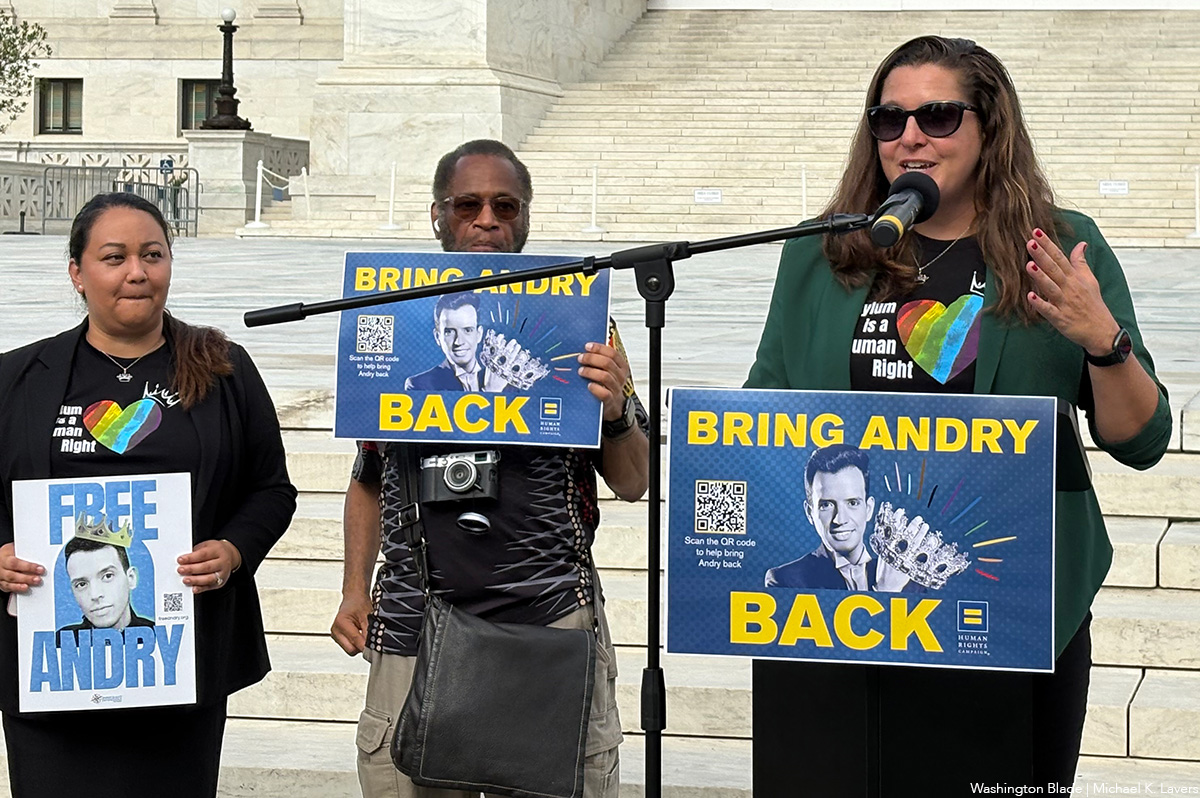
More than 200 people gathered in front of the U.S. Supreme Court on Friday and demanded the Trump-Vance administration return to the U.S. a gay Venezuelan asylum seeker who it “forcibly disappeared” to El Salvador.
Lindsay Toczylowski, president of the Immigrant Defenders Law Center, a Los Angeles-based organization that represents Andry Hernández Romero, is among those who spoke alongside U.S. Rep. Mark Takano (D-Calif.) and Human Rights Campaign Campaigns and Communications Vice President Jonathan Lovitz. Sarah Longwell of the Bulwark, Pod Save America’s Jon Lovett, and Tim Miller are among those who also participated in the rally.
“Andry is a son, a brother. He’s an actor, a makeup artist,” said Toczylowski. “He is a gay man who fled Venezuela because it was not safe for him to live there as his authentic self.”
(Video by Michael K. Lavers)
The White House on Feb. 20 designated Tren de Aragua, a Venezuelan gang, as an “international terrorist organization.”
President Donald Trump on March 15 invoked the Alien Enemies Act of 1798, which the Associated Press notes allows the U.S. to deport “noncitizens without any legal recourse.” The Trump-Vance administration subsequently “forcibly removed” Hernández and hundreds of other Venezuelans to El Salvador.
Toczylowski said she believes Hernández remains at El Salvador’s Terrorism Confinement Center, a maximum-security prison known by the Spanish acronym CECOT. Toczylowski also disputed claims that Hernández is a Tren de Aragua member.
“Andry fled persecution in Venezuela and came to the U.S. to seek protection. He has no criminal history. He is not a member of the Tren de Aragua gang. Yet because of his crown tattoos, we believe at this moment that he sits in a torture prison, a gulag, in El Salvador,” said Toczylowski. “I say we believe because we have not had any proof of life for him since the day he was put on a U.S. government-funded plane and forcibly disappeared to El Salvador.”
“Andry is not alone,” she added.
Takano noted the federal government sent his parents, grandparents, and other Japanese Americans to internment camps during World War II under the Alien Enemies Act. The gay California Democrat also described Hernández as “a political prisoner, denied basic rights under a law that should have stayed in the past.”
“He is not a case number,” said Takano. “He is a person.”
Hernández had been pursuing his asylum case while at the Otay Mesa Detention Center in San Diego.
A hearing had been scheduled to take place on May 30, but an immigration judge the day before dismissed his case. Immigrant Defenders Law Center has said it will appeal the decision to the Board of Immigration Appeals, which the Justice Department oversees.
“We will not stop fighting for Andry, and I know neither will you,” said Toczylowski.
Friday’s rally took place hours after Attorney General Pam Bondi said Kilmar Abrego Garcia, a Maryland man who the Trump-Vance administration wrongfully deported to El Salvador, had returned to the U.S. Abrego will face federal human trafficking charges in Tennessee.
National
A husband’s story: Michael Carroll reflects on life with Edmund White
Iconic author died this week; ‘no sunnier human in the world’
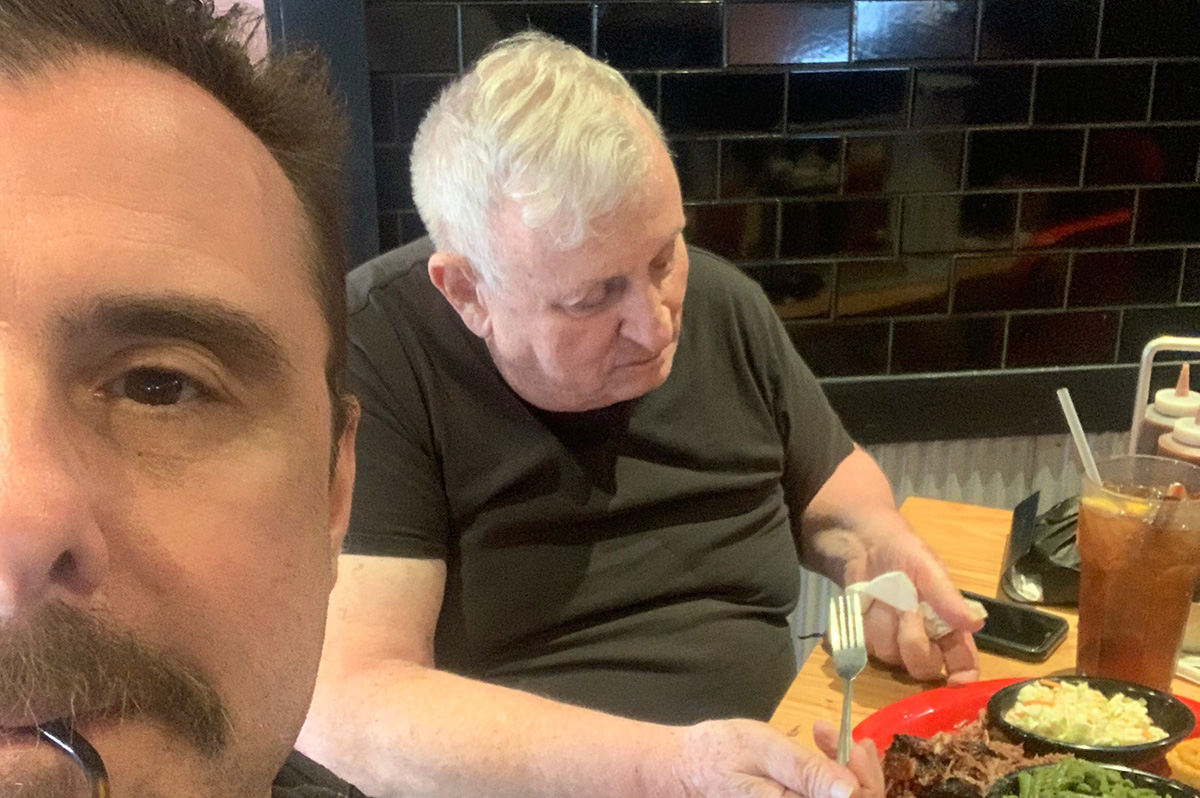
Unlike most gay men of my generation, I’ve only been to Fire Island twice. Even so, the memory of my first visit has never left me. The scenery was lovely, and the boys were sublime — but what stood out wasn’t the beach or the parties. It was a quiet afternoon spent sipping gin and tonics in a mid-century modern cottage tucked away from the sand and sun.
Despite Fire Island’s reputation for hedonism, our meeting was more accident than escapade. Michael Carroll — a Facebook friend I’d chatted with but never met — mentioned that he and his husband, Ed, would be there that weekend, too. We agreed to meet for a drink. On a whim, I checked his profile and froze. Ed was author Edmund White.
I packed a signed copy of Carroll’s “Little Reef” and a dog-eared hardback of “A Boy’s Own Story,” its spine nearly broken from rereads. I was excited to meet both men and talk about writing, even briefly.
Yesterday, I woke to the news that Ed had passed away. Ironically, my first thought was of Michael.
This week, tributes to Edmund White are everywhere — rightly celebrating his towering legacy as a novelist, essayist, and cultural icon. I’ve read all of his books, and I could never do justice to the scope of a career that defined and chronicled queer life for more than half a century. I’ll leave that to better-prepared journalists.
But in those many memorials, I’ve noticed something missing. When Michael Carroll is mentioned, it’s usually just a passing reference: “White’s partner of thirty years, twenty-five years his junior.” And yet, in the brief time I spent with this couple on Fire Island, it was clear to me that Michael was more than a footnote — he was Ed’s anchor, editor, companion, and champion. He was the one who knew his husband best.
They met in 1995 after Michael wrote Ed a fan letter to tell him he was coming to Paris. “He’d lost the great love of his life a year before,” Michael told me. “In one way, I filled a space. Understand, I worshiped this man and still do.”
When I asked whether there was a version of Ed only he knew, Michael answered without hesitation: “No sunnier human in the world, obvious to us and to people who’ve only just or never met him. No dark side. Psychology had helped erase that, I think, or buffed it smooth.”
Despite the age difference and divergent career arcs, their relationship was intellectually and emotionally symbiotic. “He made me want to be elegant and brainy; I didn’t quite reach that, so it led me to a slightly pastel minimalism,” Michael said. “He made me question my received ideas. He set me free to have sex with whoever I wanted. He vouchsafed my moods when they didn’t wobble off axis. Ultimately, I encouraged him to write more minimalistically, keep up the emotional complexity, and sleep with anyone he wanted to — partly because I wanted to do that too.”
Fully open, it was a committed relationship that defied conventional categories. Ed once described it as “probably like an 18th-century marriage in France.” Michael elaborated: “It means marriage with strong emotion — or at least a tolerance for one another — but no sex; sex with others. I think.”
That freedom, though, was always anchored in deep devotion and care — and a mutual understanding that went far beyond art, philosophy, or sex. “He believed in freedom and desire,” Michael said, “and the two’s relationship.”
When I asked what all the essays and articles hadn’t yet captured, Michael paused. “Maybe that his writing was tightly knotted, but that his true personality was vulnerable, and that he had the defense mechanisms of cheer and optimism to conceal that vulnerability. But it was in his eyes.”
The moment that captured who Ed was to him came at the end. “When he was dying, his second-to-last sentence (garbled then repeated) was, ‘Don’t forget to pay Merci,’ the cleaning lady coming the next day. We had had a rough day, and I was popping off like a coach or dad about getting angry at his weakness and pushing through it. He took it almost like a pack mule.”
Edmund White’s work shaped generations — it gave us language for desire, shame, wit, and liberation. But what lingers just as powerfully is the extraordinary life Ed lived with a man who saw him not only as a literary giant but as a real person: sunny, complex, vulnerable, generous.
In the end, Ed’s final words to his husband weren’t about his books or his legacy. They were about care, decency, and love. “You’re good,” he told Michael—a benediction, a farewell, maybe even a thank-you.
And now, as the world celebrates the prolific writer and cultural icon Edmund White, it feels just as important to remember the man and the person who knew him best. Not just the story but the characters who stayed to see it through to the end.
District of Columbia
In town for WorldPride? Take a D.C. LGBTQ walking tour
Scenes of protest, celebration, and mourning
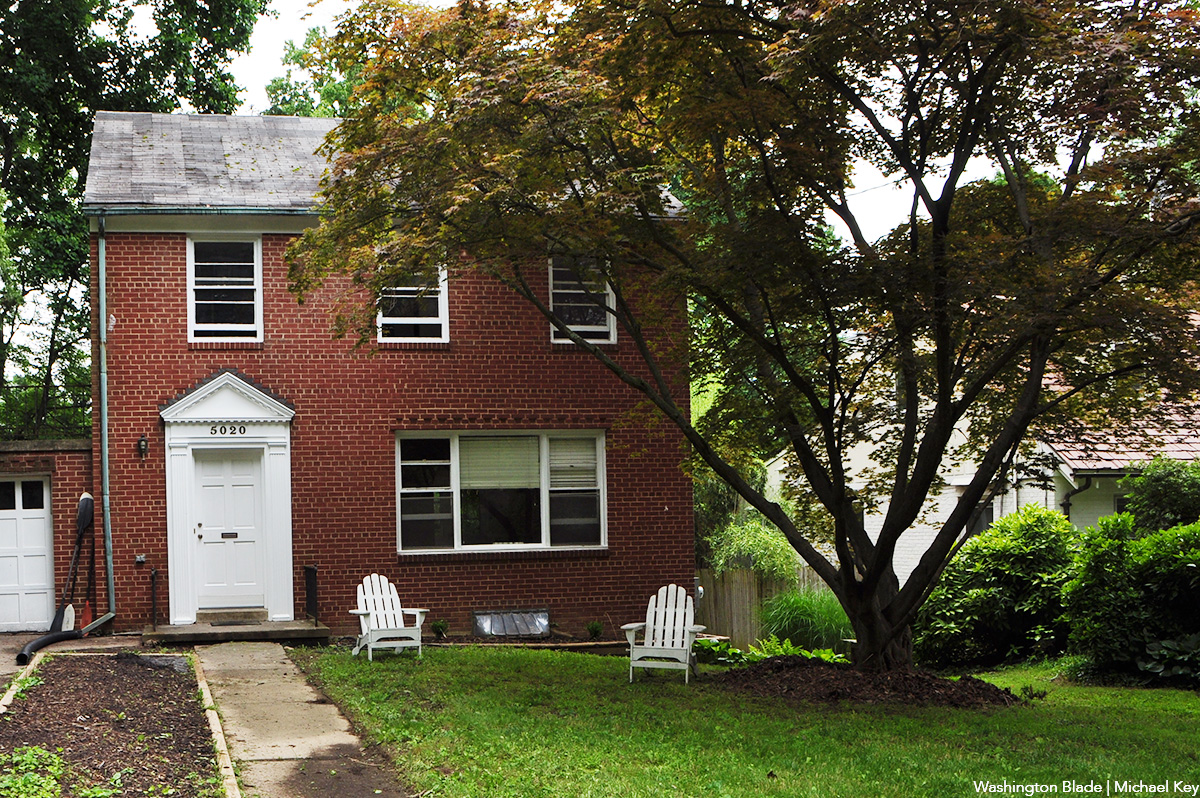
As Washington welcomes the world for WorldPride, it’s essential to honor the city’s deep-rooted LGBTQ history—an integral part of the broader story of the nation’s capital. The following locations have served as cornerstones of queer life and activism in D.C., shaping both local and national movements for LGBTQ rights. So take a walk around “the gayest city in America” and check out these sites.
DUPONT CIRCLE AREA
Dupont Circle
Central hub of LGBTQ life since the early 20th century, hosting Pride parades, Dyke Marches, and cruising culture. A long-standing site of protests and celebrations.
Washington Hilton – 1919 Connecticut Ave NW
Hosted D.C.’s first major hotel drag event in 1968 and the iconic Miss Adams Morgan Pageant. Protested in 1978 during Anita Bryant’s appearance.
Lesbian Avengers – 1426 21st St NW
Formed in 1992, the group empowered lesbians through bold direct actions. They met in Dupont Circle and launched the city’s first Dyke March.
Lambda Rising Bookstore (former) – 1724 20th Street NW
D.C.’s first LGBTQ bookstore and the birthplace of the city’s inaugural Pride celebration in 1975.
Women In The Life (former office) – 1623 Connecticut Ave NW
Founded in 1993 by Sheila Alexander-Reid as a safe space and support network for lesbians of color.
17th Street NW Corridor – Between P & R Streets NW
Core of the LGBTQ business district, home to the annual High Heel Race in October and the June Block Party celebrating the origins of D.C. Pride.
CAPITOL HILL / SOUTHEAST
Tracks (former) – 80 M St SE
Once D.C.’s largest gay club, famous for inclusive parties, RuPaul shows, and foam nights from 1984 to 2000.
Ziegfeld’s / The Other Side – 1345 Half Street SE
Legendary drag venue since 1978, hosting famed performers like Ella Fitzgerald.
Club 55 / Waaay Off Broadway – 55 K Street SE
Converted theater central to D.C.’s early drag and Academy pageant scenes.
Congressional Cemetery – 1801 E Street SE
Resting place of LGBTQ figures like Sgt. Leonard Matlovich and Peter Doyle. Offers queer history tours.
Mr. Henry’s – 601 Pennsylvania Ave SE
LGBTQ-friendly bar since 1966 and the launching stage for Roberta Flack’s career.
The Furies Collective House – 219 11th Street SE
Home to a 1970s lesbian feminist collective that published “The Furies.” Members included Rita Mae Brown.
ARCHIVES / PENN QUARTER
Archives Metro & Center Market Site – 7th St & Pennsylvania Ave NW
Where Walt Whitman met Peter Doyle in 1865, commemorated by a sculpture linking Whitman and poet Fernando Pessoa.
COLUMBIA HEIGHTS / PETWORTH
Palm Ballroom (former) – 4211 9th Street NW
Mid-20th century venue for Black drag balls and LGBTQ events during segregation.
NATIONAL MALL AREA
National Mall / Washington Monument Grounds
Historic site of LGBTQ activism and remembrance, including the 1987 display of the AIDS Memorial Quilt and a mass same-sex wedding. Hosted major civil rights marches in 1979, 1987, and 1993.
NORTHWEST DC
Dr. Franklin E. Kameny House – 5020 Cathedral Ave NW
Home of gay rights pioneer Frank Kameny and the Mattachine Society of Washington; now a national landmark.
LAFAYETTE SQUARE / WHITE HOUSE
Lafayette Park – Pennsylvania Ave & 16th St NW
Historic gay cruising area and epicenter of government surveillance during the Lavender Scare.
Data from: SSecret City by James Kirchick, The Deviant’s War by Frank Kameny, Brett Beemyn, The Rainbow History Project, NPS Archives, Washington Blade Archives.

